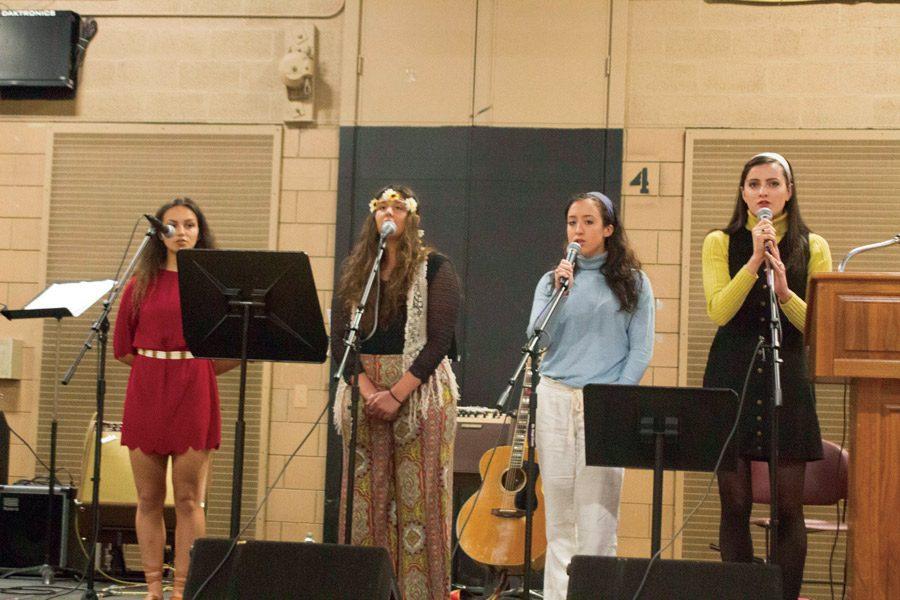Patriot Perspective: Admin, students need to build inclusive community
Seniors Faith Ensor, Nicolette Ficca, Hailey Schilling, and Lilly Stannard perform during the Peace and Justice Assembly on April 6. The Assembly featured singing and speeches from students and faculty about inclusivity, discrimination, and diversity.
Awkwardly standing in the last few minutes of class, listening to classmates talk about a party happening during the upcoming weekend, senior international student Stephania Ortega shames the idea because she feels like she isn’t good enough.
This awkward isolation is not unusual for international students. The administration has created a dynamic community featuring students from all over the world and has integrated those cultures in various ways. We applaud the administration for the Peace and Justice Assembly and their efforts to integrate the diverse groups of the world into our school community.
However, the efforts on the part of both administrators and students to integrate different communities are not comprehensive enough, and never seem to fully accomplish their purposes.
The school has limited its focus on acceptance to a handful of cultures, and groups like the LGBT community are left out. Areas where the school focuses on diversifying, such as the international student program, often lack depth, and only make superficial accomplishments.
The school even went as far as creating a diversity statement, but in the same fashion as many of their endeavors to create an environment of acceptance, students are unaware of the new code, and the community has yet to experience the fruits of the administration’s labor on the statement.
Although JC emphasizes the importance of diversity in cultures, they fail to mention the LGBT community and what we as a school can do to be accepting towards it. There are assemblies and clubs that help raise awareness about diversity, but there is nothing for the LGBT community that helps unite students and embrace their identities.
A club advocating for LGBT identities will not only strengthen our community, but will assist students in their journey to accept themselves and come out, if they have not done so. This club, however, should not limit itself to members of the LGBT community, but should be open to those who aim to create an environment of acceptance and understanding at JC.
While the school needs to widen its focus on diversity and acceptance of all God’s creatures, it also needs to follow through with the programs it has already established, such as the international student program, and make sure that programs like these actually come to fruition.
According to the JC website, “The John Carroll School has a well-established international student program that supports and furthers the mission of the School in developing students who will embrace opportunities and excel as responsible participants in the global society.”
It is incredible to walk down the hall and hear three different languages within five minutes, and the ability to hear global perspectives on controversial issues in the classroom creates a wealth of opportunity for students.
However, a lot of the global perspective we have through the international program is simply observational. Yes, people from all parts of the world are in the same buildings and classrooms as each other, but that doesn’t mean personal interaction and bonding always occurs.
Students are partly at fault for the lack of communication and should take responsibility for making international students feel welcome.
“We feel shy because our English grammar mistakes makes us feel like we are less than the American students,” Ortega said. “[The] administration doesn’t care, they expect American students to take care of making us feel welcome.”
One international student from China cited the “spoon game” as an example of this lack of interaction between international and domestic students. The “spoon game” was a fun, informal game that members of the senior class made up, but “none of the international students were told about the game, and it seemed like everyone else was included but us.”
While this is just one simple example, it is a representation of the feelings that international students often have. Domestic students observe the international students in our community but oftentimes we forget that interaction is the key to gain a global perspective and fulfill the aspirations of JC’s international student program.
An effort was made two years ago to help promote relationships between domestic and foreign students through the international student mentoring program. Unfortunately, this program died once the leaders of the program graduated. The administration needs to permanently establish programs such as this to promote international communication, but students must also go out of their way to encourage the development of an accepting and diverse community.
While the school needs to improve some of its efforts, it is also the student body’s responsibility to interact with each other and make a diverse atmosphere a reality, not just a pitch to lure prospective students into attending JC.
Student involvement is necessary in more areas than just building relationships with international students. Through the diversity committee, students were handed the opportunity to take charge of developing an environment of inclusion and acceptance, but when no one took charge, the committee fell through the cracks and never produced results.
Student leaders must be proactive in embracing all diverse backgrounds and encouraging their classmates to do so as well. Students did an excellent job contributing to the Peace and Justice assembly and they were able to use their voices to express the discrimination against their races and cultures.
Creating a truly diverse community requires students to take ownership. In order to take the next step, students must appreciate and encourage diverse viewpoints and lifestyles within their own context.
Diversity stretches beyond race and culture and can be embraced in beneficial ways. With a few adjustments and by following the path JC has laid for us, the community will become a happier environment and will therefore become a place where everyone can feel accepted.




